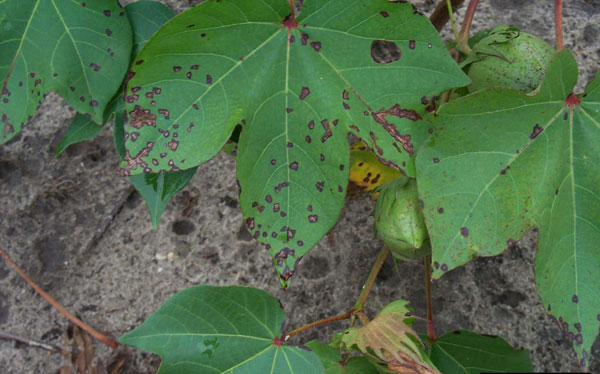Introduction
First described in the United States in 1891, bacterial blight (also called angular leaf spot, boll rot, and black leg) has been a major disease in cotton. Though it has only been detected sporadically in North Carolina, it is a potentially destructive bacterial disease for the state. Cotton yield losses caused by bacterial blight have been previously reported in excess of 10%.
Pathogen
Bacterial blight is caused by a bacterium, Xanthomonas citri pv. malvacearum (formerly Xanthomonas axonopodis pv. malvacearum).
Symptoms
Bacterial blight infections can affect any above-ground portions of the plant and at any point of plant development. Lesions associated with Xanthamonas begin as an angular leaf spot with a red to brown border (Figure 1). Tissues surrounding lesions may also become yellow, giving the appearance of a "halo" surrounding the lesion. The angular appearance of lesions is due to restriction of the lesion by fine veins of the cotton leaf, and bacteria may spread along the leaf veins causing blackened lesions along major veins.
Leaf petioles and stems may also become infected (cotton black leg) (Figure 2), which can lead to premature defoliation of the plant. Black cankers on stems or branches may girdle the plant causing the portions to die above the canker. Additionally, a white waxy crust containing the bacterium may also form on old leaf spots or cankers.
Infected bolls have round, as opposed to angular, lesions that initially may appear water-soaked, and then become sunken and dark brown to black. Bolls infected with Xanthamonas may result in rotted seed and discolored lint.
Disease Cycle
Xanthamonas citri survives in infested crop debris, seeds, and volunteer seedlings. Acid-delinting cotton seed has been instrumental in minimizing the spread of seedborne bacterial blight through contaminated seed. Significant rainfall events and high humidity combined with warm temperatures favor disease development. The bacteria enter leaf tissues through the plants natural openings (stomates) and wounds, and disease is most severe following storms that produce heavy rains and/or hail. The bacteria can spread through wind-blown rain or irrigation, as well as unsanitized tools and equipment used in infested fields.
Management
There are no remedial management tools available to stop disease development. Preventative cultural practices may be implemented to reduce disease incidence.
Crop Rotation
-
Crop rotation with any other field crop is effective at reducing disease pressure.
-
The host range of the bacteria blight pathogen, as a pathovar (pv) group, is limited to malvaceous plants, such as cotton.
-
At Planting
-
Plant high-quality, disease free, acid delinted seed.
-
Plant blight-resistant varieties where available.
Growing Season
-
Regulating plant growth during the growing season to prevent rank growth may help reduce disease incidence.
-
Reducing the humidity within the canopy and increasing the rate of drying of the foliage may also limit the progression of this disease.
-
Scout fields and identify infected plants and varieties
After Harvest
-
Avoid cultivation or other activities, such as moving equipment through fields that may cause damage to plant tissues when foliage is wet to reduce potential infection sites on cotton plants.
-
If a field becomes infested, harvest that field as soon as possible.
-
Determine and record the cotton variety, seed lot, and a disease severity rating.
-
Destroy all stalks and other debris from fields, as soon after harvest as possible. Till debris as deep into the soil as possible, while managing soil erosion.
-
Burning is not an effective control method as it only removes the debris on the surface. If burning is used to remove excess debris, it should be combined with tillage to push debris to deeper levels of soil.
-
Useful Resources
- The NC State University Plant Disease and Insect Clinic provides diagnostics and control recommendations.
- The NC State Extension Plant Pathology portal has disease information and news updates on disease in North Carolina.
- The Cotton portal has agronomic and pest information related to cotton production.
- For information on resistance varieties, see publication from Beltwide Cotton Conference.
Publication date: March 15, 2017
Reviewed/Revised: Feb. 2, 2024
N.C. Cooperative Extension prohibits discrimination and harassment regardless of age, color, disability, family and marital status, gender identity, national origin, political beliefs, race, religion, sex (including pregnancy), sexual orientation and veteran status.
NC Cooperative Extension prohíbe la discriminación por raza, color, nacionalidad, edad, sexo (incluyendo el embarazo), discapacidad, religión, orientación sexual, identidad de género, información genética, afiliación política, y estatus de veteran.
Recommendations for the use of agricultural chemicals are included in this publication as a convenience to the reader. The use of brand names and any mention or listing of commercial products or services in this publication does not imply endorsement by NC State University or N.C. A&T State University nor discrimination against similar products or services not mentioned. Individuals who use agricultural chemicals are responsible for ensuring that the intended use complies with current regulations and conforms to the product label. Be sure to obtain current information about usage regulations and examine a current product label before applying any chemical. For assistance, contact your local N.C. Cooperative Extension county center.
N.C. Cooperative Extension prohibits discrimination and harassment regardless of age, color, disability, family and marital status, gender identity, national origin, political beliefs, race, religion, sex (including pregnancy), sexual orientation and veteran status.


